INTRODUCTION
This report is designed for midwives and nurses caring for postpartum women and premature infants in the special care nursery. The purpose of this report is to highlight the multiple benefits that infant massage has on the infant, mother (or caregiver) and the hospital. Baby massage can assist with many issues that come with a preterm baby such as bonding, feed intolerance, growth, digestion, and ultimately timely discharge.
Mothers often feel displaced by the hospital environment in their role but by teaching mothers how to massage their preterm baby it can empower them to contribute to their care. Massage is an under-utilized resource in the special care nursery and by educating staff on its benefits it can have a greater uptake on the ward resulting in better outcomes.
WHAT IS A PRETERM BABY?
The World Health Organization (2002) defines preterm as ‘babies born alive before 37 weeks of pregnancy are completed’. Premature babies are more likely to suffer disabilities such as learning difficulties, and visual and hearing problems. These infants also lack the coordination between breathing, sucking, and swallowing so are often fed via nasogastric tubes.
Due to their immature gastrointestinal tract, these babies have an increased gastric emptying time and labile bowel movements resulting in increased gastric residual volume. This accumulates into feeding intolerance (Seiiedi-Biarag and Mirghafourvand, 2020). Another significant impact preterm babies have on feeding is it uses up a lot of their energy for suck feeds, slowing their weight gain.
Feeding tolerance is generally the final hurdle in the special care nursery prior to discharge and can be difficult to overcome as it takes time for the gastrointestinal tract to develop. Preterm babies can take a considerable amount of time to coordinate the suck/swallow ability without tiring before completing an oral feed.
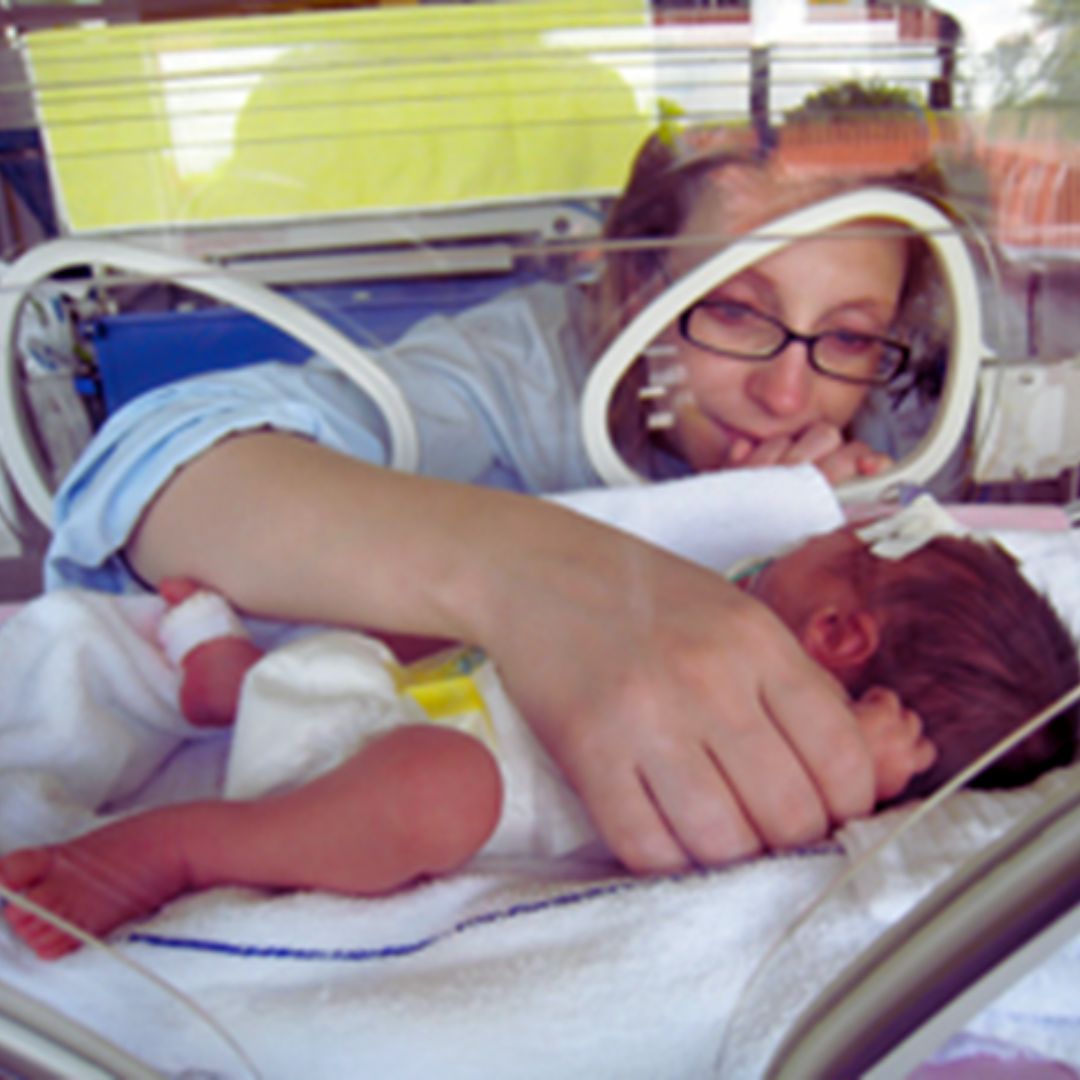.jpg?lang=en-AU)
Mother gazing at and holding the hand of a premature infant in an incubator (St Lukes Kansas City, 2020).
EFFECTS OF PRETERM BIRTH
As reported by Lotfalipour et al. (2019) 70% to 80% of mothers of preterm infants experience high levels of stress which are expressed by restlessness, crying, anxiety, depression, and irritability. This is due to a sense of alienation, lack of control and feelings of guilt and disappointment surrounding the premature birth.
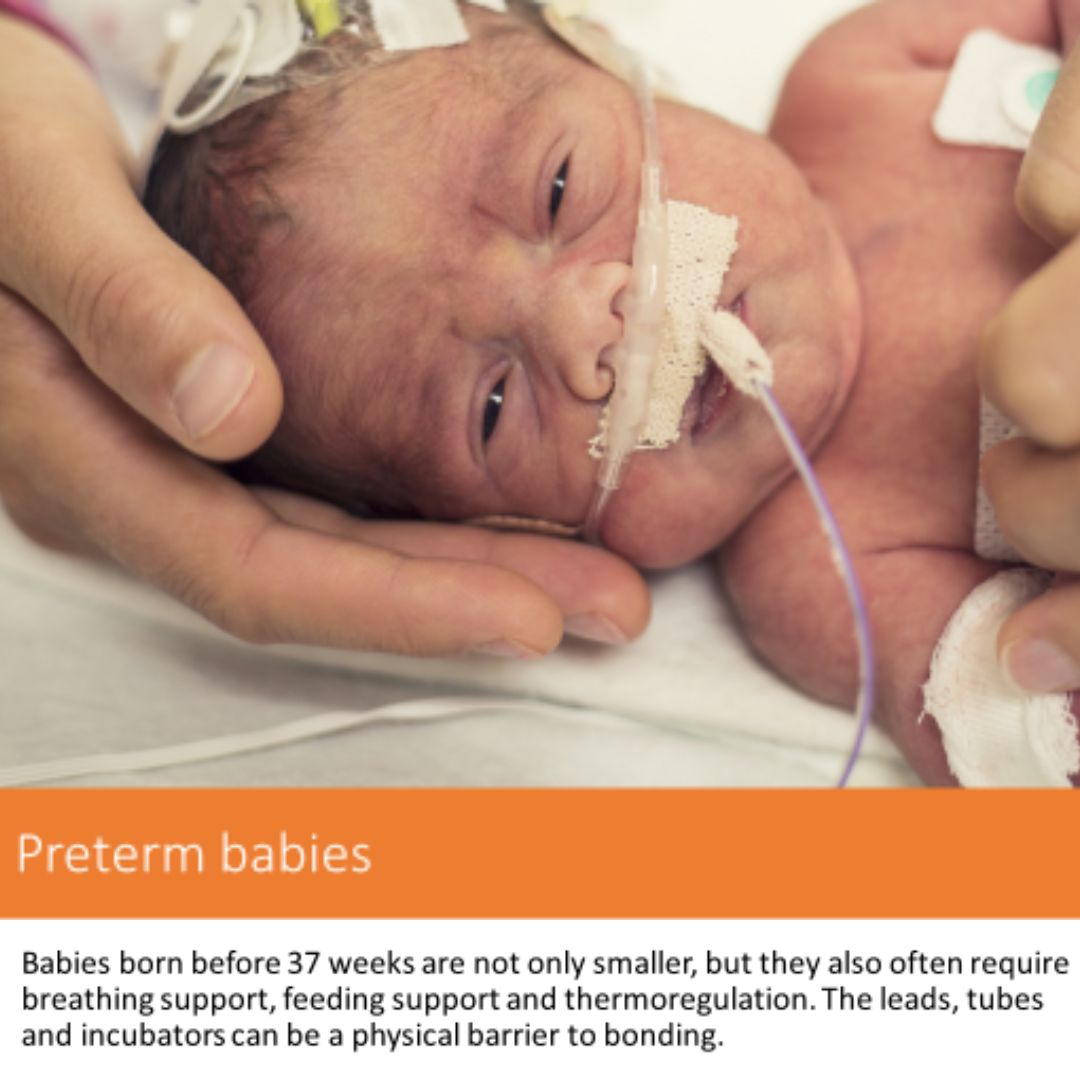
The study currently being undertaken by Lai et al. (2016) on the mother-baby relationship and neurodevelopment of the preterm infant highlighted that premature birth is a risk factor for stress, postpartum post-traumatic stress disorder, depression, and difficulty with bonding and attachment. Furthermore, the increased levels of stress, anxiety and depression experienced by the mother further impact the bonding experience with the baby.
Other than the maternal barriers there are many physical barriers to bonding with the infant in the nursery. Due to the inability to thermoregulate the baby is often cared for in an incubator with monitoring and may or may not be on respiratory support. All these cords and wires can cause hesitation in the mother to have the confidence to touch or hold their baby. The mother may feel the baby is “safer” or need to rest rather than be touched.
A nurse’s role is to encourage this bond and support the mother to be involved in the infant's care while supporting the mother emotionally and mentally.
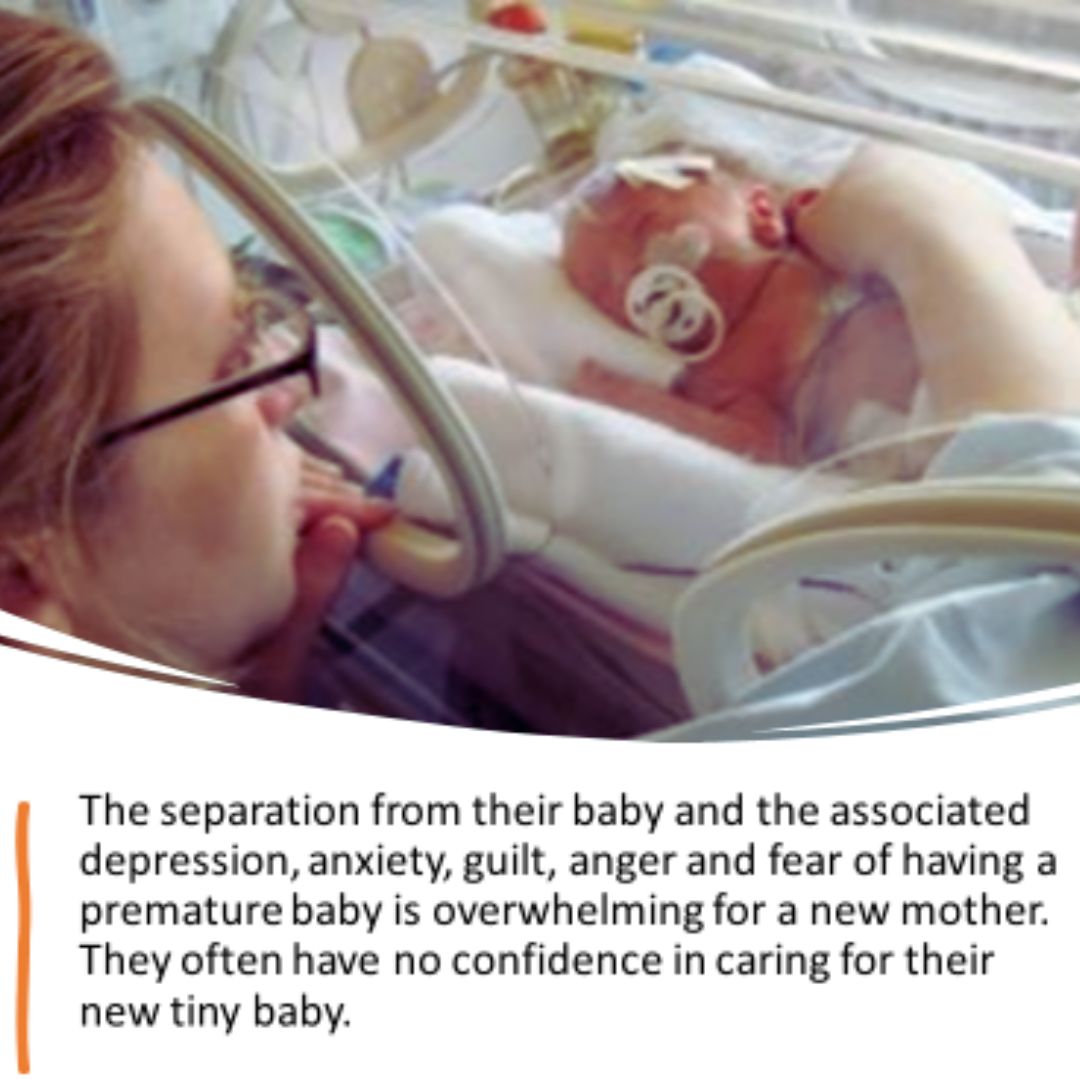
BENEFITS OF MASSAGE
Whilst there are many benefits for the baby receiving the massage, there are also crucial benefits for the mother (or caregiver) providing the massage as demonstrated below. As highlighted above, the mother needs just as much support and care in the special care nursery as the infant.
While patient care is foremost, it should also be noted the high cost of admission of a preterm infant in the special care nursery on hospital resources. Massage can also assist in relieving some pressure from the hospital system as described below.
BENEFITS FOR PRETERM BABIES
With skin being the largest organ and most developed sense, touch is incredibly important for babies who are still developing their other senses. For premature babies, the benefits of massage are significant and have a positive outcome on health. These benefits are summarized by Greene (2013) below:
- Decreased stress responses.
- Increased serotonin and melatonin levels - improving sleep rhythms.
- Increased vagal activity aids digestion, respiratory function, and circulation.
- Improved pulmonary function.
- Reduced complications from drug use in pregnancy.
- Improved motor function.
- Enhanced bonding and attachment.
- Increased myelination rate of the brain and nervous system.
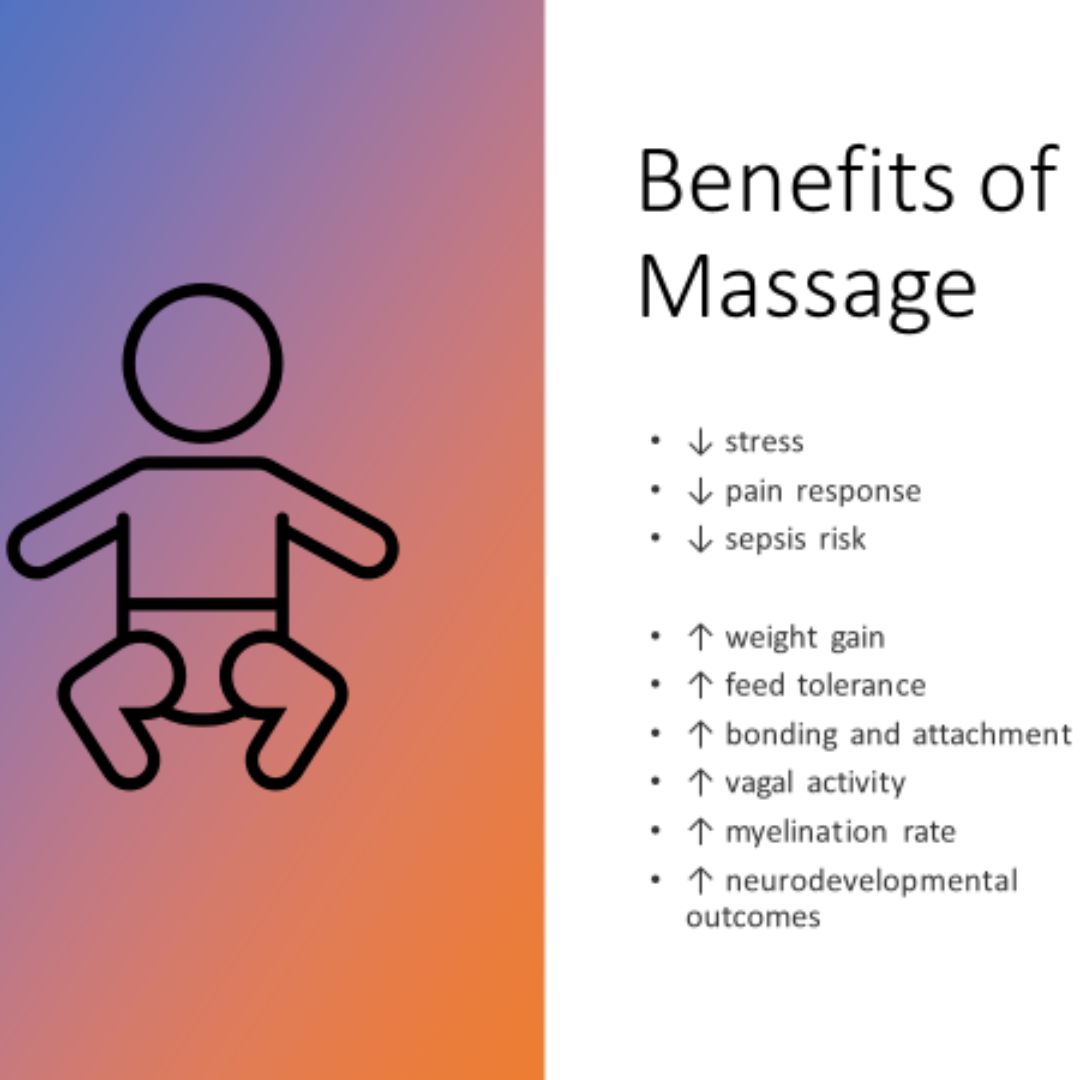
Further research has found the below benefits in addition to the above:
- Improved feeding tolerance (Seiiedi-Biarag and Mirghafourvand, 2020).
- Improved neurodevelopmental outcome (Procianoy et al. 2010).
- Reduced risk of neonatal sepsis (Alvarez et al. 2017).
- Pain relief (Abdallah et al. 2013).
- Higher cognitive levels at 12 months of age (Abdallah et al. 2013).
- 15 trials with 697 participants showed that massage therapy improved daily weight gain by 5.07 g/day (Li-Chin et al. 2020).
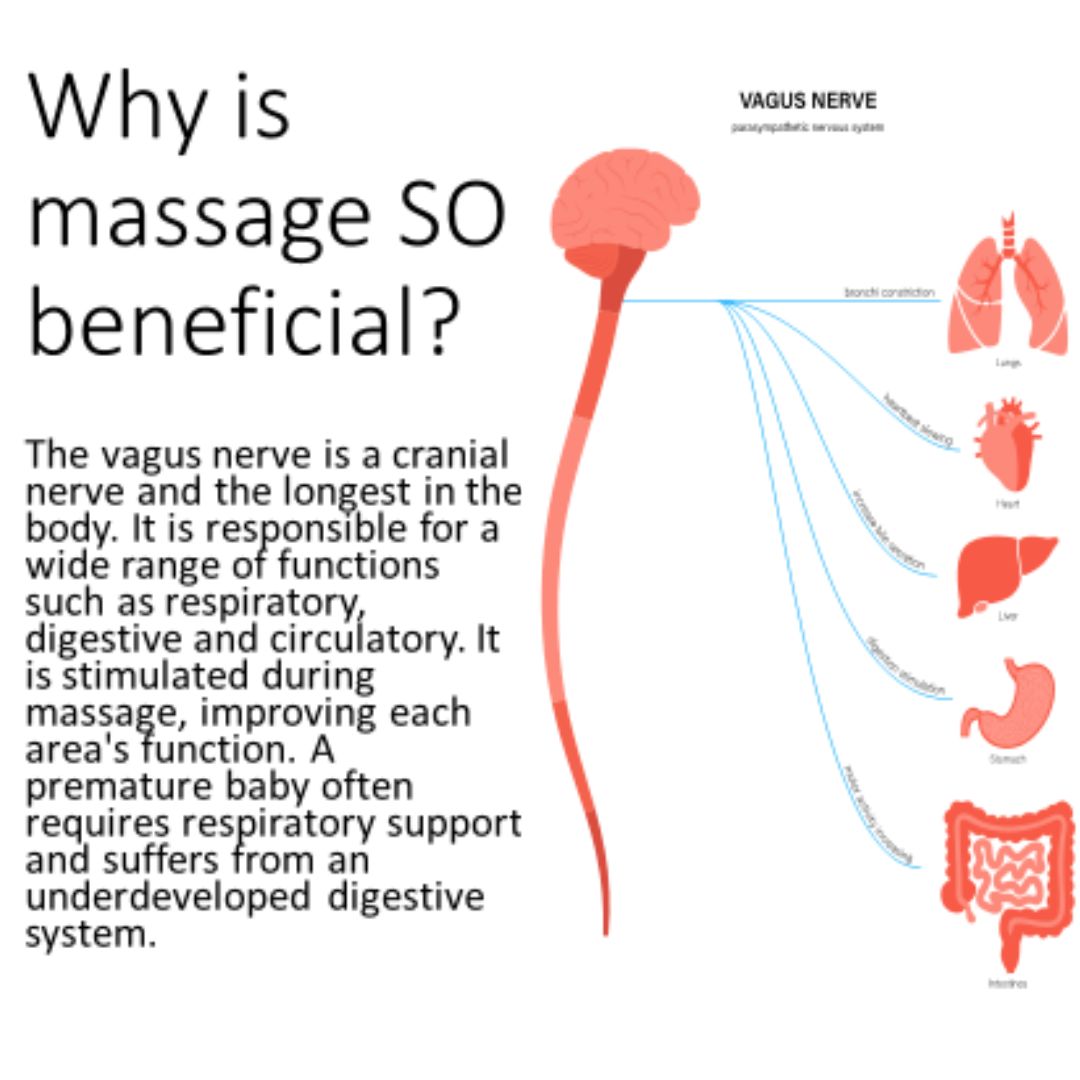
The below graph (figure 1) from Hendy et al. (2022) study of 120 infants in a NICU in Egypt demonstrates the effect an abdominal massage prior to a gavage feed had on their post-feed state. The control group did not receive a massage and 40% were crying post-feed compared to 10% who did receive a massage. This can be interpreted to improve feed tolerance resulting in faster weight gain and thus discharge.
Figure 1: Post-feed states (Hendy et al. 2002)
BENEFITS FOR THE MOTHER
It is imperative that when premature infants are going home from the hospital that they are going home to a safe, competent, and confident caregiver. The special care nursery can be isolating and stressful, removing a mother’s confidence in caring for their baby. The benefits of teaching the mother how to massage their baby are listed below:
- Decreased state of anxiety (Afand et al. 2017)
- Lower levels of depression
- More sensitive to babies’ cues
- Increased knowledge, confidence, and interaction with baby (Mainous 2002)
Empowering the mother with this skill gives her a sense of purpose in the medical environment of the nursery in contributing to her baby’s care. Like basic hygiene care which is often encouraged for the parents to carry out, massage can be an extra opportunity to bond and support their baby.

BENEFITS FOR THE UNIT
Prematurity costs hospitals approximately 15.5 billion dollars in costs per year. Following intensive care treatment, weight gain becomes the main criterion for discharge (Field et al. 2010). Educating parents on how to provide infant massage can promote weight gain for the premature infant to facilitate a reduction in hospitalization duration.
Research has shown that when a mother is taught massage it can reduce the costs compared with a massage performed by a nurse, which is expensive and time-consuming. Massage is not only economic, but it also has no serious adverse effects, drug reactions, or interactions and can result in a quicker discharge reducing the cost to the hospital (Lotfalipour et al. 2019).
- Reduced hospitalization time (Seiiedi-Biarag and Mirghafourvand, 2020)
- Decreased need for resources such as medication and nasogastric tubes.
Mainous (2002) suggested massage is becoming a component of developmental care alongside regulating other stimuli and providing supportive care such as swaddling due to its benefits on growth and development. By making it a mainstream component of care in the nursery the above benefits can all be achieved with excellent outcomes at no cost and will assist in decreasing the nurse’s workload.

WEIGHT GAIN AND DISCHARGE
Feeding intolerance in the preterm baby is often a key factor in preventing discharge due to their immature gastrointestinal system. This means they are fed via nasogastric tube while learning to coordinate their suck and swallow ability as well as tolerate feed volumes essential for weight gain. This can result in a lot of vomiting, tiring, constipation, reflux, and feed refusal making weight gain a slow process.
In regional nurseries in Australia discharge requires the babe to be achieving all feeds orally and tolerating volumes with consistent weight gain and weight above 2.5kg.
Abdominal massage has a positive effect on the digestive system by stimulating the vagus nerve and gastric motility thus enhancing intestinal peristalsis, reducing abdominal distension, improving bowel transit and defecation times, reducing vomiting, and enhancing the sleep state (Hendy et al. 2022). This achieves target weights much quicker resulting in a faster discharge than babies not massaged.
Field et al. (2010) review of massage therapy in preterm infants found babies who received 5-10 days of massage had a 21-48% increase in weight gain and in turn were discharged 3-6 days earlier than those who did not receive massage. This highlights the benefit of massage with weight gain in getting preterm infant home sooner.
By having the mother incorporate an abdominal massage with care prior to feeds it can be part of a routine to support the development and facilitate better-tolerated feeds, weight gain and thus discharge.
FREQUENTLY ASKED QUESTIONS
What if the baby is too sick/unstable for massage?
We always go by babies’ cues, so if massage isn’t appropriate at the time the baby will still benefit from touch such as kangaroo care or a simple containment hold. Mothers should check with a nurse or doctor if unsure. Kangaroo care and containment hold still has fantastic benefits and should be supported by nursing staff.
When is the best time to do a baby massage on the unit?
It is recommended baby be in a quiet alert state as described in Table 1 (Humphreys et al. 2015). By using the permission sequence and reading babies' cues we can identify if it is an appropriate time. It is not recommended post-bath as preterm infants are very stimulated by bath time and massage will overstimulate them. Also, be mindful not to do an abdominal massage until at least 30 minutes post-feed to avoid the risk of vomiting.

Table 1: States of arousal (Humphreys et al. 2015)
Should we use any cream or oils?
As summarized in Field et al. 2010 review of massage in the preterm population, babies that received a massage using oils demonstrated increased weight gain compared to those with no medium. Using coconut oil or safflower oil demonstrated the best weight gain and higher triglyceride levels through transcutaneous absorption however it is important to weigh up the benefits against scent and allergy. Synthetic oil also had weight gain without the allergy risk. Ideally organic, cold-pressed oils are recommended however follow your local hospital policy or use what is available as some oil is better than no oil.

Can anyone perform the massage?
The primary caregiver/caregivers should perform the massage to help establish a bond and for the emotional and mental benefits. It also establishes appropriate touch for the infant. Training the primary caregiver empowers them to care for their baby and can continue at home. It is a low-cost and time-efficient strategy to improve discharge times.
What if it is done too hard and hurts the baby?
As stated by Field et al. 2010 the massage should be done with moderate pressure. If done too softly you will not see benefits and it is likely to annoy the baby. You should be able to see the skin move beneath your fingers and go by babies’ cues if they are enjoying it or not.
Can anyone teach the parents, or should we know how to massage?
It is preferred that parents are taught by a qualified Paediatric Massage Consultant to get the most benefit without overstimulating the baby. By having a Paediatric Massage Consultant educate the parent they can also learn specific techniques for wind, colic, and constipation. Due to this, it is preferable at least one staff member is trained in massage. Training can be done through Infant Massage Information Service.
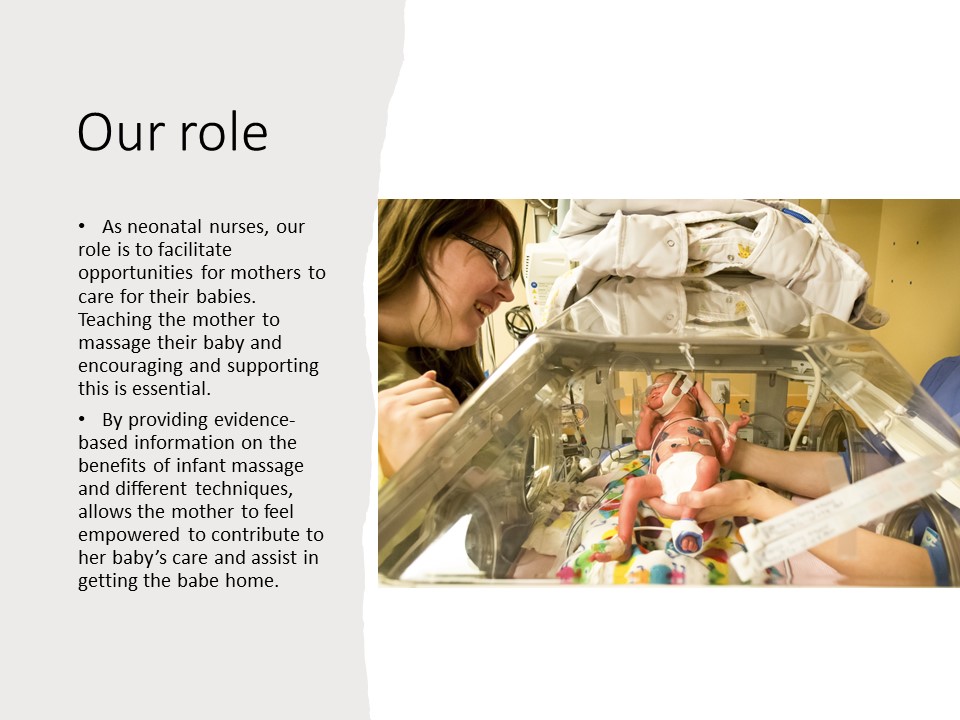.JPG)
Are there any contraindications for massage?
McDowell (2017) listed the below contraindications for massage. In these instances, medical clearance is required prior.
- Acute infections
- Recent Surgery
- Fever
- Open wounds
- Less than 72 hours after immunization
- Diarrhea
- Inflammation
- Undiagnosed lumps and bumps
- Jaundice
- Contagious Disease
- Meningitis
- Serious Skin Complaints
- Recent Hemorrhage
- Leukemia
CONCLUSION
Infant massage should be taught to parents in all neonatal units as a routine standard of care. It needs to be seen as a supportive measure in the unit as important as swaddling, reducing sensory environment and positioning for the preterm baby. Empowering mothers through teaching infant massage, ensures more positive outcomes for both mother and baby and quicker discharge times. Providing massage to premature babies and assisting with their digestion reduces the use of medications and interventions and it is a cost-effective, time-efficient nursing intervention to provide greater care to our patients.
REFERENCE LIST
Abdallah, B, Badr, L. K, & Hawwari, M, 2013, ‘The efficacy of massage on short and long term outcomes in preterm infants’, Infant behavior & development, vol. 36, no. 4, pp. 662–669, doi: 10.1016/j.infbeh.2013.06.009
Afand, N, Keshavarz, M, Fatemi, N, & Montazeri, A, 2017, ‘Effects of infant massage on state anxiety in mothers of preterm infants prior to hospital discharge’, Journal of Clinical Nursing, vol. 26, no. 13-14, pp. 1887-1892, doi: 10.1111/jocn.13498
Álvarez, M. J, Fernández, D, Gómez-Salgado, J, Rodríguez-González, D, Rosón, M, & Lapeña, S, 2017 ‘The effects of massage therapy in hospitalized preterm neonates: A systematic review’, International journal of nursing studies, vol. 69, pp. 119–136, doi: 10.1016/j.ijnurstu.2017.02.009
Field, T, Diego, M & Hernandez-Reif, M, 2010, ‘Preterm Infant Massage Therapy Research: A Review’. Infant Behav. Dev, vol. 33, no. 2, pp. 115-124, doi: 10.1016/j.infbeh.2009.12.004
Greene, A, 2013, “Touch is as important to infant health as eating and sleeping’, Dr Greene, accessed 22 February 2023, https://www.drgreene.com/touch-is-as-important-to-infant-health-as-eating-and-sleeping
Hendy, A, El-Nagger, N. S, Abozeid, A, Reshia, F. A, Salih, S. A, Alruwaili, M. F, & Hendy, A, 2022 ‘Outcome of abdominal massage before gavage feeding on tolerated feeding for low birth weight infants’, Nursing Open, vol. 9, pp. 1060– 1065, doi: 10.1002/nop2.1144
Humphreys, K, Zeanah, C & Scheeringa, M, 2015 ‘Infant Development: The First 3 Years of Life’ Psychiatry, vol. 4, pp. 134-158, doi: 10.1002/9781118753378.ch9
Lai, M, D’Acunto, G, Guzzetta, A, Boyd, A, Rose, S, Fripp, J, Finnigan, S, Ngenda, N, Love, P, Whittingham, K, Pannek, K, Ware, R & Colditz, P, 2016, “PREMM: preterm early massage by the mother: protocol of a randomised controlled trial of massage therapy in very preterm infants”, BMC Pediatrics, vol. 16, no. 146, doi: 10.1186/s12887-016-0678-7
Li-Chin, L, Shao-Huan, L, Yen-Ping, H, Long-Yau, L, Jong-Chen, C, Shou-Jen, L, 2020, ‘Massage therapy for weight gain in preterm neonates: A systematic review and meta-analysis of randomized controlled trials’, Complementary Therapies in Clinical Practice, vol. 39, doi: 10.1016/j.ctcp.2020.101168
Lotfalipour B, Tirgari B, Pouraboli B, Mirzaee M, 2019, ‘Effect of Preterm Infant Massage by the Mother on the Mood of Mothers Having Preterm Infants’, Journal of Chiropractic Medicine, vol. 18, no. 1, pp. 67-76, doi: 10.1016/j.jcm.2018.11.001
Mainous, R 2002, ‘Infant massage as a component of developmental care: past, present, and future’, Holistic Nursing Practice, vol. 16, no. 5, pp. 1–7, doi: 10.1097/00004650-200210000-00004
McDowell, C, 2017, Infant massage contraindications, Physicaltherapy.com, accessed 23 March 2023, < https://www.physicaltherapy.com/ask-the-experts/infant-massage-contraindications-3413>.
Mother of preterm baby, digital photograph, St Luke’s Kansas City, accessed 21 March 2023, https://www.saintlukeskc.org/health-library/interacting-your-premature-baby-nicu.
Procianoy, R, Mendes, E, Silveira, R, 2010 ‘Massage therapy improves neurodevelopment outcome at two years corrected age for very low birth weight infants’, Early Human Development, vol. 86, no. 1, pp. 7-11, doi: 10.1016/j.earlhumdev.2009.12.001
Seiiedi-Biarag, L, Mirghafourvand, M, 2020, ‘The effect of massage on feeding intolerance in preterm infants: a systematic review and meta-analysis study’, Italian Journal of Pediatrics, vol. 46, no. 52, doi: 10.1186/s13052-020-0818-4
World Health Organisation 2022, Preterm birth, World Health Organisation, viewed 16 March 2023.
Enjoy helping babies & their parents in this rewarding field

Met my expectations and more. I loved all of it. I was given good information and paperwork to reflect back on. The class facilitator was an awesome trainer who made the course really interesting and easy to understand.

I haven’t studied for years and didn’t think I would enjoy the course soo much. Professional, friendly, approachable . I absolutely loved it and our instructor Heidi was so knowledgeable and just lovely.

If you are thinking of a qualification in Infant Massage then I would not go anywhere else. These guys were great and very professional. Our trainer Paula was patient and thorough in her approach. I really enjoyed it and would highly recommend them.

Easy and informative. Went above what I was expecting.
Request a brochure
Related information
How much does an infant massage therapist make?
What does an infant massage therapist do?
How do I become an infant massage therapist?
Correspondence intake periods
Request a course brochure
Enrol today